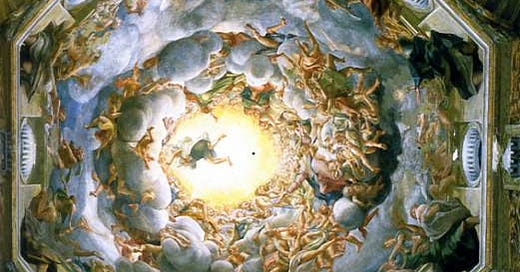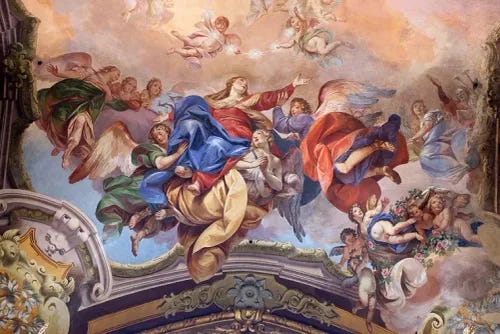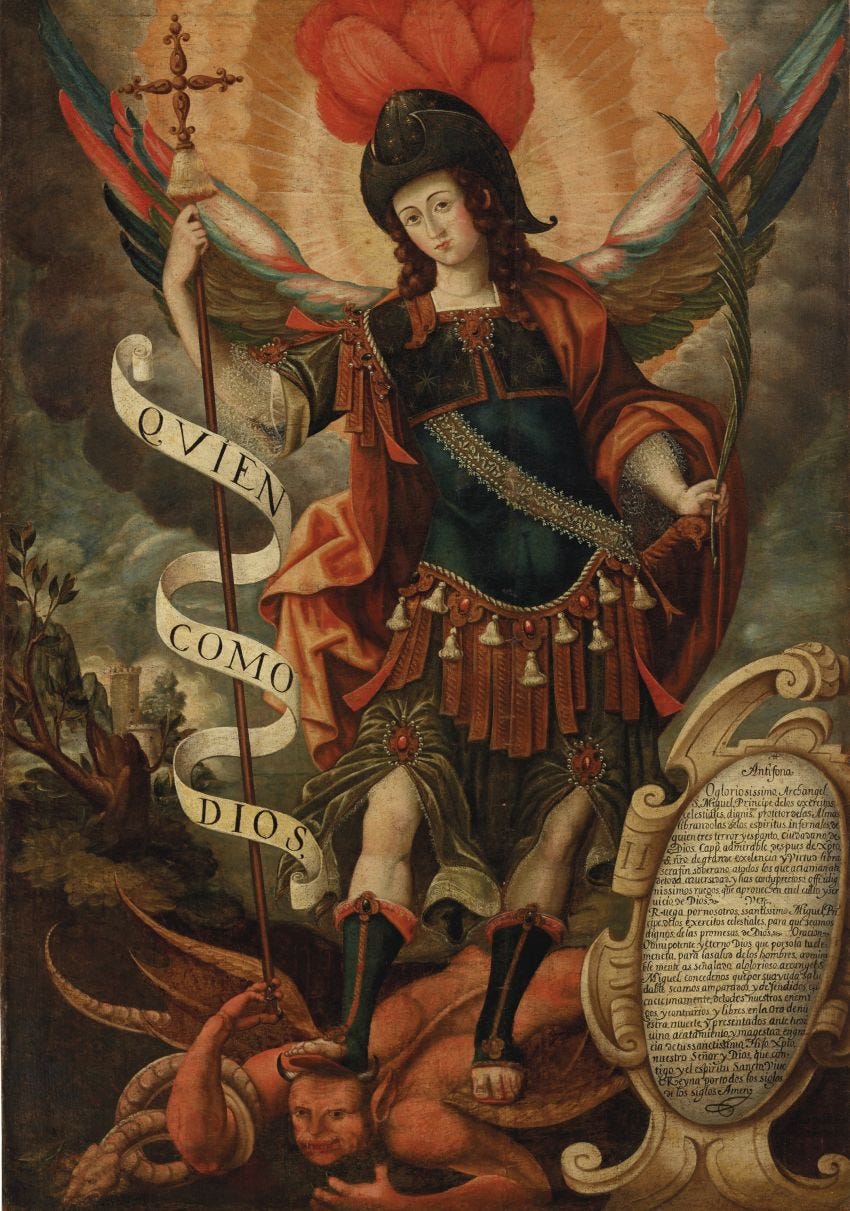On this day, a Holy Day of Obligation, we recall Our Lady's being assumed into Heaven. Though the Church has always believed in the Assumption of Mary, the dogma was only formally defined by Pope Pius XII in 1950 in his Bull Munificentissimus Deus. Note that Mary was assumed into Heaven -- taken up by the power of God, like Elias and Enoch -- while Christ ascended into Heaven under His own power. He took her up because she is His mother, and He loves her; she was able to be taken up because He made her holy -- "full of grace" -- and did so from the moment of her conception, which we honor on December 8. Psalm 131:8 foretells of her being taken up --
Arise, O Lord, into thy resting place: thou and the ark, which thou hast sanctified.
And St. John's Patmos vision, recorded in the Apocalypse, includes Our Lady, in Heaven, crowned:
And the temple of God was opened in heaven: and the ark of His testament was seen in His temple, and there were lightnings, and voices, and an earthquake, and great hail. And a great sign appeared in heaven: A woman clothed with the sun, and the moon under her feet, and on her head a crown of twelve stars... (Apocalypse 11:19-12:1)
According to the Catholic Encyclopedia, the date of Mary's dormition (her "falling asleep" into death) is placed from anywhere between 3 and 15 years after Our Lord's Ascension, when she had lived seventy-two years. Most beautifully, the cause of her death was neither disease, nor violence, nor senescence; it was, according to tradition, love -- a desire to be reunited with her Son. After three days in the tomb, her body and soul were reunited, and she was assumed by the power of God, whereupon, according to Apocalypse 8:1, "there was silence in heaven, as it were for half an hour." The site of these events is remembered either as Jerusalem, where her tomb has been placed since around the 6th century, or Ephesus. At any rate, St. John Damascene (John of Damascus, A.D. 676 - 754/787) writes:
St. Juvenal, Bishop of Jerusalem, at the Council of Chalcedon (A.D. 451), made known to the Emperor Marcian and Pulcheria, who wished to possess the body of the Mother of God, that Mary died in the presence of all the Apostles, but that her tomb, when opened, upon the request of St. Thomas, was found empty; wherefrom the Apostles concluded that the body was taken up to heaven.
According to tradition, however, Our Lady's tomb was not exactly found empty; lilies and roses were found where her body "should" have been. Maria Von Trapp relates the story in her book "Around the Year with the Trapp Family," and, in the process, relates a legend that explains why herbs and flowers came to be associated with this Feast:
The connection between the feast of the Assumption and the blessing of herbs is told in an old legend When Mary the Mother of Jesus felt that her end was drawing near, she sent her guardian angel to summon the Apostles, who had gone out into the world to preach the Gospel of her Son, Our Lord Jesus Christ. When they received the summons, they came in a great hurry and were just in time to witness the happy death of their dear Mother. Everyone had come except Thomas. He was three days late. When he heard that the Blessed Mother had been resting in the tomb for days, he cried bitterly and pled with the Apostles to open the tomb once more and let him glance at the beloved features. The other Apostles yielded to his plea, but as they opened the tomb, they found it filled with flowers, which gave out a heavenly scent. On the place where they had laid the body there was only the shroud left — the body had been borne up to heaven by the angels, where it was joined by the holy soul of the Mother of God. According to the legend, all the flowers and herbs on earth had lost their scent after Adam and Eve committed the first sin in the Garden of Eden. On the day of the Assumption of the Blessed Mother, however, the flowers were given back their scent and the herbs their power to heal.
The Roman Ritual includes a blessing for those herbs and flowers, which raises them to the status of sacramentals. In many parishes and chapels, congregants will bring fresh flowers to adorn the church in Mary's honor, and will bring the same along with fruit and herbs -- especially healing herbs -- to be blessed and take home. The blessed herbs are used throughout the year, especially in food made for the sick.1
CUSTOMS
While the folks from Australia and New Zealand hash it out over which country came up with the dessert first, a pavlova remains the perfect thing to make today to make good use of the fruit. The "pav's" fluffy meringue and mounded whipped cream resemble clouds, which brings to mind Our Lady's being taken up into the Heavens. A recipe:
Pavlova
6 egg whites
1/4 tsp salt
1/4 tsp cream of tartar
1 1/2 cups sugar
2 Tbsp cornstarch
1 Tbsp white vinegar
1 1/2 tsp vanilla
1 1/2 cups whipping cream
3 cups sliced fruit (I like strawberries and blueberries)
Line a baking sheet with parchment paper.
In a bowl, beat egg whites, salt and cream of tartar until soft peaks form. Gradually beat in sugar in thin steady stream until stiff glossy peaks form. Sift in cornstarch; fold in vinegar and vanilla. Batter should be a marshmallow consistency. Spoon batter onto prepared pan in the shape of an 8-inch or so circle; smooth top (or make slightly bowl-like, piping sides on, if desired). Bake at 275 F oven for 2 to 2 1/2 hours or until crisp and lightly browned on outside but still soft in middle. Let cool completely (meringue may deflate). Run knife under meringue. Carefully remove paper. (Meringue can be loosely covered and stored for up to 3 days.) Remove loose bits from meringue.
Whip cream (you can sweeten it with sugar if you like); spread over top of meringue. Garnish top with fruit, preferably in a pretty pattern. Eat right away.
In some coastal areas, the seas are also blessed on this day, especially in fishing communties. The passages from the 21st chapter of the Gospel of St. John in which Jesus went fishing with His Apostles are read, along with sections of Luke 5. The Magnificat is prayed and then the sea is sprinkled with Holy Water and the Sign of the Cross made over it. It is believed that to swim in the waters blessed on this day is curative.
In Italy, this day is also known as Ferragosto, and it has its origins in a holiday instituted by the Emperor Augustus on August 1. Ferragosto was a day of rest, and workers who wished their employers "buon ferragosto" would get a bonus, a custom that still prevails. The Church moved the celebration of this holiday to the Feast of the Assumption, and today and surrounding days -- for the next two weeks -- are days Italians take off work and use to travel, have barbecues and picnics, and otherwise have a good time and rest.
Since 1582, in Palmi, Italy -- in the region of Calabria -- the Assumption is also honored on the last Sunday of August. This celebration, which is known as "la Varia di Palmi," is preceded by a procession the day before, and on the Sunday itself comes an even more magnificent procession, one with a great 50-feet tall shoulder-borne platform that represents the universe. The platform is adorned with figures representing the Apostles and angels, with Mary being assumed into Heaven at the top.
In Croatia, where this feast is known as Velika Gospa, today is a major holiday. And nowhere is it celebrated as grandly there as it is in the city of Sinj. Throngs of pilgrims journey -- often barefoot -- to the city in order to honor an image of the Virgin kept at the Sanctuary of the Miraculous Lady of Sinj. To the sounds of cannons and bells, a great procession is held, and firemen, military men, veterans, the religious, girls in their traditional costumes -- everyone takes part, processing, praying the Rosary, chanting litanies, and singing.
In the diocese of Lafayette in Louisiana, U.S.A., the Feast of the Assumption has been marked by a procession that takes place by boat rather than on foot. The Fête-Dieu du Teche begins with a Mass at the Church of the Assumption in Franklin, and is followed by processing the Blessed Sacrament to a boat on the Bayou Teche. The boat then goes up river, making three stops on its route, ending up at St. Peter's Church in New Iberia. Many churches have been built along the bayou, and people line the way to reverence Christ. People who live along the bayou build shrines for the occasion.
The Feast of the Assumption marks the beginning of a totally optional period of sacrifice called "St. Michael's Lent." It lasts 40 days -- from today until September 29, the Feast of St. Michael the Archangel (like all such sacrifical devotions, Sundays and other holy days are excluded). "St. Michael's Lent" is made in emulation of St. Francis, who kept this period as a sort of personal Lent in honor of Our Lady and St. Michael, a custom which spread to his fellow Franciscans. It ends with a Consecration to St. Michael the Archangel.
If you missed our Celebration of the Feast of St Joseph the Worker, you missed a fantastic event. Don’t make the same mistake this September!
Check out this fantastic piece from our last speaker, Fr. Robert McTeigue, SJ…
https://crisismagazine.com/opinion/parishes-preparing-their-people-for-what-exactly
and his most recent interview with our next speaker, Fr. John Perricone!
Be a sponsor, buy a table, or get your tickets today to help us renew this great tradition of our Faith!
As a note your previously purchased season tickets your season ticket will of course be honored for our final two events of the 2024 season.
Please contact us with any questions via (813) 720-7002 or don@orricosc.com.
See you in September for 'a Festa 'e Tutte 'e Feste' with Fr John Perricone and the Fraternal Society of St John the Apostle!
https://fisheaters.com/customstimeafterpentecost6.html








